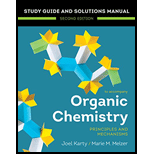
Concept explainers
(a)
Interpretation:
From the given segment of a nucleic acid, it is to be determined whether it is a segment of RNA or DNA.
Concept introduction:
The small molecular units from which
(b)
Interpretation:
From the given segment of a nucleic acid, each nucleotide should be circled and named.
Concept introduction:
Nucleotides are distinguished from one another by identifying the nitrogenous bases attached to the sugar group. In both, RNA and DNA, it is the specific sequence of the nitrogenous bases that determines the genetic information that is stored or carried. There are four types of five nitrogenous bases that could be present in RNA and DNA. Uracil, guanine, adenine, cytosine, thymine are the nitrogenous bases present in RNA and DNA. In a nucleotide, the
Want to see the full answer?
Check out a sample textbook solution
Chapter 1 Solutions
Organic Chemistry: Principles And Mechanisms: Study Guide/solutions Manual (second)
- Detergents need not be ionic. Pentaerythrityl palmitate (shown here) is a nonionic detergent used in dishwashingliquids.(a) Identify the hydrophilic and hydrophobic portions of the molecule.(b) Draw a depiction of a micelle that would form if this compound were dissolved in water.(c) What intermolecular interactions are primarily responsible for the micelle’s solubility in water?(d) What advantages do nonionic detergents have over ionic detergents in hard water?arrow_forwardDuring our lectures on polymeric materials, I used polyethylene as an example because of its very straightforward structure. (a.) Ethylene (C2H4) is a colorless flammable gas. Draw a diagram to show what a single molecule of this gas looks like. Show all bonds with the following symbol (—). Recall that the bonds are highly covalent in nature.arrow_forward(b) Polymers play essential and ubiquitous roles in our everyday life because of their broad spectrum of properties. (i) List TWO (2) polymers that you encounter everyday. (ii) Describe the properties of each polymer in (i).arrow_forward
- Give a definition and an example for each class of organic compounds.(a) alkane (b) alkene (c) alkyne(d) alcohol (e) ether (f) ketonearrow_forward(d) H₂C=CH₂ NaOH(aq), CHCl3, A CI CIarrow_forward42. Write the name of the molecule. (a) (d) CH.CH_CH(CH)C=CCH_CH, (e) CH₂ (CH3)₂CHC=CCH(CH3)2 (c) (f) ОН CH3 CH₂CH₂-C-C CH CH₂CH₂CH₂arrow_forward
- What are chromophores?arrow_forward2) a) b) Write the condensed structure for the following molecules: O OHarrow_forwardThe protein glycophorin A has a sugar group covalently attached to it. It is an example of a de ce à glycoprotein metalloprotein hemoprotein lipoprotein nucleoprotein Ophosphoproteinarrow_forward
- What are [C] and [D]?arrow_forwardWhy is that the Organic Chemistry separated as branch of Chemistry?arrow_forward(a) Polymers are classified into natural and synthetic polymers. (i) Differentiate between the synthetic and natural polymers based on their mechanical properties. (ii) Give ONE (1) example each for natural and synthetic polymers.arrow_forward
 Introductory Chemistry: An Active Learning Approa...ChemistryISBN:9781305079250Author:Mark S. Cracolice, Ed PetersPublisher:Cengage Learning
Introductory Chemistry: An Active Learning Approa...ChemistryISBN:9781305079250Author:Mark S. Cracolice, Ed PetersPublisher:Cengage Learning Chemistry for Today: General, Organic, and Bioche...ChemistryISBN:9781305960060Author:Spencer L. Seager, Michael R. Slabaugh, Maren S. HansenPublisher:Cengage Learning
Chemistry for Today: General, Organic, and Bioche...ChemistryISBN:9781305960060Author:Spencer L. Seager, Michael R. Slabaugh, Maren S. HansenPublisher:Cengage Learning ChemistryChemistryISBN:9781305957404Author:Steven S. Zumdahl, Susan A. Zumdahl, Donald J. DeCostePublisher:Cengage Learning
ChemistryChemistryISBN:9781305957404Author:Steven S. Zumdahl, Susan A. Zumdahl, Donald J. DeCostePublisher:Cengage Learning Chemistry: An Atoms First ApproachChemistryISBN:9781305079243Author:Steven S. Zumdahl, Susan A. ZumdahlPublisher:Cengage Learning
Chemistry: An Atoms First ApproachChemistryISBN:9781305079243Author:Steven S. Zumdahl, Susan A. ZumdahlPublisher:Cengage Learning
 World of Chemistry, 3rd editionChemistryISBN:9781133109655Author:Steven S. Zumdahl, Susan L. Zumdahl, Donald J. DeCostePublisher:Brooks / Cole / Cengage Learning
World of Chemistry, 3rd editionChemistryISBN:9781133109655Author:Steven S. Zumdahl, Susan L. Zumdahl, Donald J. DeCostePublisher:Brooks / Cole / Cengage Learning





